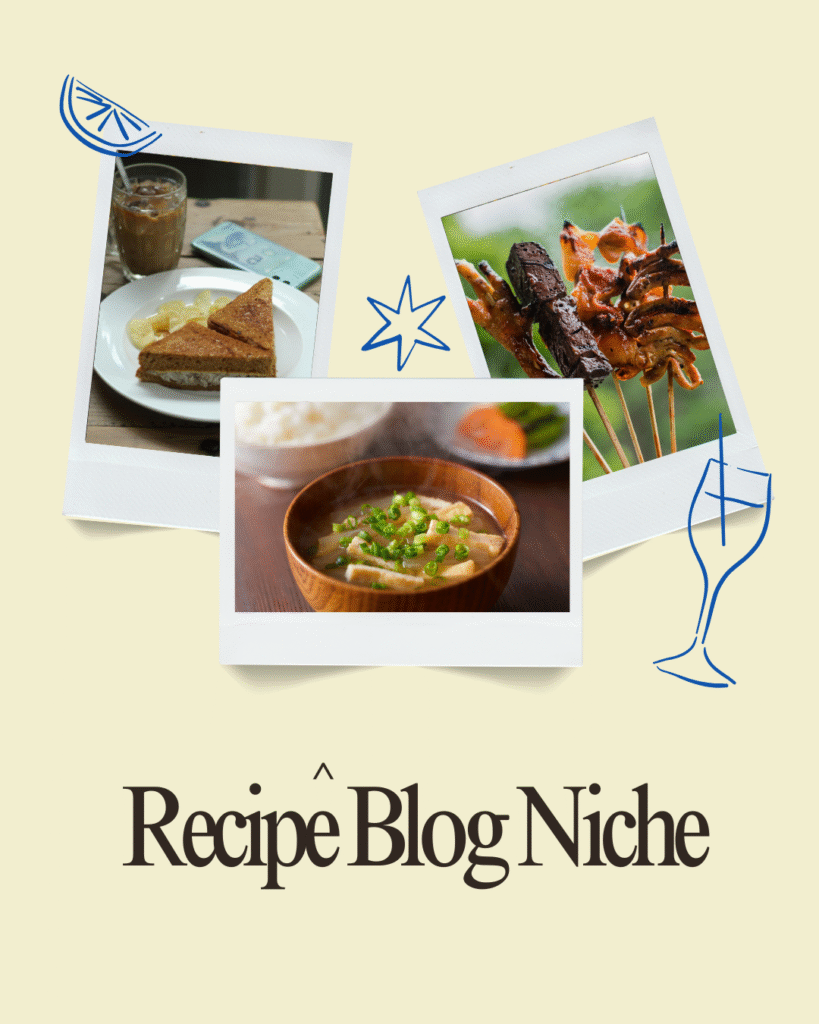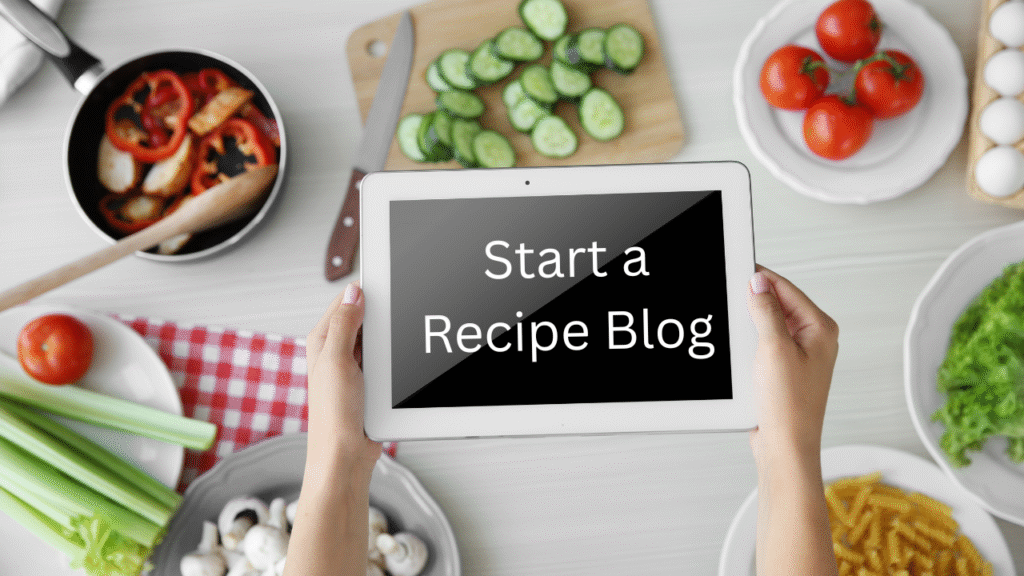Starting a recipe blog in 2025 is an exciting opportunity to share your passion for food, connect with a global audience, and potentially turn your culinary creativity into a profitable venture. With the food blogging industry growing alongside the $4.4 trillion global food and beverage market, there’s never been a better time to launch your own platform. This comprehensive guide covers everything you need to know about how to start a recipe blog, from choosing a niche to monetizing your content. Whether you’re a home cook, professional chef, or food enthusiast, this step-by-step guide will help you build a successful recipe blog in 2025.
Why Start a Recipe Blog in 2025?
Recipe blogs combine creativity, community, and commerce, offering unique benefits:
- High Demand: Food-related content accounts for 17% of online searches, with recipes driving significant traffic (Google Trends, 2025).
- Monetization Potential: Earn through ads, sponsorships, affiliate marketing, or cookbooks.
- Creative Outlet: Share your culinary expertise and unique recipes with a global audience.
- Low Startup Costs: Start with minimal investment using affordable hosting and tools.
- SEO Opportunities: Food blogs thrive on long-tail keywords like “easy vegan dinner recipes” or “gluten-free dessert ideas.”
- Community Building: Engage with food lovers through comments, social media, and newsletters.
With trends like AI-generated recipes, video content, and sustainable cooking shaping 2025, a recipe blog can tap into a vibrant, ever-growing niche. Let’s dive into the steps to get started.
Tip: Optimize for how to start a recipe blog 2025 to target aspiring bloggers.
Step-by-Step Guide to Starting a Recipe Blog
Step 1: Choose Your Recipe Blog Niche

Why It Matters: A focused niche helps you stand out in a crowded market, attract a targeted audience, and rank higher for specific keywords.
Popular Niches for 2025:
- Healthy Eating: Vegan, keto, gluten-free, or low-carb recipes.
- Cultural Cuisine: Authentic Italian, Indian, or Mexican dishes.
- Quick Meals: 30-minute dinners or meal prep ideas.
- Sustainable Cooking: Plant-based or zero-waste recipes.
- Baking and Desserts: Specialty cakes, pastries, or gluten-free treats.
- Budget Cooking: Affordable meals for students or families.
How to Choose:
- Identify Your Passion: Focus on recipes you love to cook and share.
- Research Demand: Use tools like Google Trends or AnswerThePublic to find trending topics (e.g., “air fryer recipes” spiked 40% in 2025).
- Analyze Competition: Search for keywords like “vegan recipes” or “quick dinner ideas” to assess competition and gaps.
- Consider Your Audience: Target specific groups, such as busy parents or fitness enthusiasts.
Example: A niche like “vegan air fryer recipes” combines trending diets with popular cooking methods, ensuring relevance and searchability.
Pro Tip: Avoid overly broad niches (e.g., “recipes”). Instead, aim for specific long-tail keywords like “easy vegan air fryer snacks” to boost SEO.
Step 2: Pick a Memorable Blog Name and Domain
Why It Matters: Your blog name and domain are your brand’s identity, impacting memorability and SEO.
Tips for Choosing a Name:
- Keep It Relevant: Include food-related terms (e.g., “Bite,” “Sizzle,” “Spoon”).
- Make It Catchy: Short, memorable names like “TastyTrove” or “SavorSimple” work well.
- Check Availability: Ensure the domain and social media handles are available.
- Incorporate Keywords: Use terms like “recipes,” “kitchen,” or “cook” for SEO (e.g., “VeganVibesKitchen.com”).
Domain Registration:
- Use registrars like Namecheap ($8.98/year) or GoDaddy ($9.99/year).
- Opt for a .com domain for credibility, but .co or .kitchen are trendy alternatives.
- Check availability with tools like Domain.com or Google Domains.
Example: “PlantBasedBites.com” is niche-specific, SEO-friendly, and memorable.
Pro Tip: Secure matching social media handles (e.g., @PlantBasedBites) to maintain brand consistency across platforms.
Step 3: Choose a Reliable Web Hosting Provider
Why It Matters: Your hosting provider affects site speed, uptime, and SEO performance. A fast, reliable host ensures a great user experience.
Top Hosting Providers for 2025:
- Hostinger ($2.99/month, 4-year plan):
- 100 GB NVMe SSD storage, unlimited bandwidth.
- LiteSpeed servers for fast loading (TTFB ~400 ms).
- Free domain, SSL, and Cloudflare CDN.
- 99.99% uptime guarantee.
- SiteGround ($3.99/month):
- Optimized for WordPress with 10 GB SSD storage.
- Google Cloud infrastructure for global speed.
- Free SSL, CDN, and daily backups.
- 99.98% uptime.
- Bluehost ($2.95/month):
- WordPress-recommended with 50 GB SSD storage.
- Free domain and SSL for 1 year.
- 99.9% uptime, ideal for US audiences.
Recommendation: Hostinger is the best choice for budget-conscious bloggers due to its low cost, NVMe storage, and LiteSpeed servers, which boost SEO and user experience.
Steps:
- Sign up for a hosting plan (e.g., Hostinger’s Premium Shared Hosting).
- Register your domain during checkout.
- Enable auto-renewal to avoid losing your domain.
- Use the hosting provider’s setup wizard to install WordPress.
Pro Tip: Choose a hosting plan with at least 50 GB storage and unlimited bandwidth to handle recipe images and traffic spikes.
Read More : Best Web Hosting for Start Recipes Blog
Step 4: Set Up Your Blog with WordPress
Why It Matters: WordPress powers 43% of websites in 2025, offering flexibility, SEO plugins, and recipe-specific themes.
Steps to Set Up:
- Install WordPress: Use your host’s one-click installer (e.g., Hostinger’s hPanel or Bluehost’s cPanel).
- Choose a Theme:
- Free Themes: Astra or Neve (lightweight, customizable).
- Premium Themes: Foodie Pro ($129/year) or Cook’d Pro ($129/year) for recipe-specific layouts with printable recipe cards.
- Install Essential Plugins:
- Yoast SEO: Optimize posts for search engines.
- WP Recipe Maker: Create SEO-friendly recipe cards with schema markup.
- Jetpack: Boosts site speed, security, and analytics.
- Smush: Compresses images for faster loading.
- Brevo or MailerLite: Builds email lists for newsletters.
- Customize Your Site:
- Add a logo (create one with Canva, free).
- Set up navigation menus (e.g., Home, Recipes, About, Contact).
- Create essential pages: About, Contact, Privacy Policy.
Pro Tip: Use WP Recipe Maker’s schema markup to rank higher in Google’s recipe carousels, driving 20–30% more traffic to your blog.
Step 5: Create High-Quality Recipe Content
Why It Matters: Engaging, SEO-optimized content is the heart of your recipe blog, attracting readers and search engines.
Content Creation Tips:
- Write Detailed Recipes:
- Include ingredients, step-by-step instructions, prep time, and serving size.
- Add personal anecdotes or cultural context to engage readers.
- Use WP Recipe Maker for structured, printable recipe cards.
- Optimize for SEO:
- Target long-tail keywords (e.g., “easy vegan chocolate cake recipe”).
- Use tools like Ahrefs ($99/month) or AnswerThePublic (free) to find low-competition keywords.
- Add schema markup for rich snippets in Google results.
- Incorporate Visuals:
- Use high-quality images (shoot with a smartphone or DSLR, edit with Canva).
- Include step-by-step photos or videos (1–2 minute TikTok-style clips perform best in 2025).
- Compress images with Smush to maintain site speed.
- Write Engaging Blog Posts:
- Create listicles (e.g., “10 Quick Vegan Breakfast Ideas”).
- Share cooking tips or ingredient guides (e.g., “Guide to Gluten-Free Flours”).
- Publish seasonal content (e.g., “Thanksgiving Dessert Recipes”).
Example Post Structure:
- H1: Easy Vegan Chocolate Cake Recipe
- H2: Why You’ll Love This Recipe
- H2: Ingredients
- H3: Substitutions
- H2: Step-by-Step Instructions
- H2: Tips for Success
- H2: Printable Recipe Card (via WP Recipe Maker)
Pro Tip: Post 2–3 recipes per week initially to build content, focusing on trending keywords like “air fryer recipes” or “plant-based meals.”
Step 6: Optimize Your Blog for SEO
Why It Matters: SEO drives organic traffic, which accounts for 53% of website visits in 2025 (BrightEdge). A well-optimized recipe blog ranks higher on Google, attracting more readers.
SEO Best Practices:
- Keyword Research:
- Use Google Keyword Planner (free) or Ahrefs to find keywords with 500–5,000 monthly searches and low difficulty.
- Example: “gluten-free pizza recipe” (3,000 searches/month, low competition).
- On-Page SEO:
- Include primary keywords in the title, URL, meta description, and first 100 words.
- Use H2/H3 tags for subheadings (e.g., “Ingredients,” “Instructions”).
- Add alt text to images (e.g., “vegan chocolate cake slice”).
- Technical SEO:
- Ensure site speed is under 2 seconds (use LiteSpeed Cache).
- Enable SSL for secure browsing (included with Hostinger).
- Submit a sitemap to Google Search Console.
- Internal and External Linking:
- Link to related recipes (e.g., “Try my Vegan Brownie Recipe”).
- Cite reputable sources like BBC Good Food or Serious Eats for credibility.
- Recipe Schema Markup:
- Use WP Recipe Maker to add structured data for ingredients, cook time, and ratings.
- Boosts chances of appearing in Google’s recipe carousel.
Pro Tip: Focus on “People Also Ask” questions from Google (e.g., “How to make vegan pizza crust?”) to create FAQ sections that drive traffic.
Step 7: Build Your Audience with Social Media and Email Marketing
Why It Matters: Social media and email marketing amplify your reach, drive traffic, and build a loyal audience.
Social Media Strategies:
- Choose Platforms:
- Pinterest: Ideal for recipes, with 70% of users searching for food content. Create pin-worthy images with Canva.
- Instagram/TikTok: Share 15–60 second recipe videos (e.g., “How to Make Vegan Tacos in 30 Seconds”).
- YouTube: Post longer recipe tutorials (5–10 minutes) for in-depth engagement.
- Content Ideas:
- Share recipe snippets, cooking tips, or behind-the-scenes content.
- Use hashtags like #VeganRecipes or #AirFryerHacks (trending in 2025).
- Post consistently (3–5 times/week per platform).
- Engage Your Audience:
- Respond to comments and DMs promptly.
- Run polls or giveaways (e.g., “Vote for the next recipe!”).
Email Marketing Strategies:
- Choose a Platform:
- Brevo (free, 300 emails/day): Affordable with CRM integration.
- MailerLite (free, 1,000 subscribers): Simple for beginners.
- Build Your List:
- Add sign-up forms to your blog (e.g., “Get Free Vegan Recipes!”).
- Offer lead magnets like a free e-cookbook or meal plan.
- Send Newsletters:
- Share weekly recipes, tips, or blog updates.
- Use Brevo’s automation for welcome emails or drip campaigns.
Pro Tip: Pin a recipe image to Pinterest with a direct link to your blog post to drive 30–50% of your initial traffic.
Step 8: Monetize Your Recipe Blog
Why It Matters: Monetization turns your passion into profit, covering hosting costs and generating income.
Monetization Methods:
- Display Ads:
- Join ad networks like Google AdSense (free) or Mediavine (requires 50,000 monthly sessions).
- Earn $0.50–$5 per 1,000 page views.
- Affiliate Marketing:
- Promote kitchen tools, ingredients, or cookbooks via Amazon Associates (4–8% commission) or ShareASale.
- Example: Link to air fryers or vegan cookbooks in recipes.
- Sponsored Posts:
- Partner with food brands or kitchenware companies (e.g., Vitamix, Thrive Market).
- Rates: $100–$1,000 per post (depends on traffic).
- Sell Digital Products:
- Create e-cookbooks or meal plans using Canva or Gumroad ($10–$50 per sale).
- Offer cooking classes via Teachable ($29/month).
- Memberships:
- Use Patreon to offer exclusive recipes or videos ($5–$20/month per patron).
Pro Tip: Start with affiliate marketing and ads, as they require minimal traffic. Aim for 10,000 monthly page views within 6–12 months to join Mediavine.
Step 9: Promote and Grow Your Blog
Why It Matters: Consistent promotion ensures steady traffic and audience growth, critical for long-term success.
Growth Strategies:
- SEO Optimization: Continuously research trending keywords and update old posts with new images or content.
- Content Frequency: Publish 2–3 posts weekly, mixing recipes with listicles or guides.
- Collaborations: Guest post on other food blogs or collaborate with influencers on Instagram/TikTok.
- Analytics: Use Google Analytics (free) to track traffic, top pages, and user behavior.
- Community Engagement: Join food blogging communities on X or Reddit (e.g., r/foodbloggers) for tips and networking.
Pro Tip: Repurpose content across platforms (e.g., turn a blog recipe into a TikTok video or Pinterest pin) to maximize reach.
Step 10: Stay Compliant and Professional
Why It Matters: Legal compliance and professionalism build trust and protect your blog.
Key Actions:
- Add Legal Pages:
- Create Privacy Policy, Terms of Use, and Disclaimer pages using Termly (free).
- Comply with GDPR for EU visitors (use cookie consent plugins like Complianz).
- Disclose Affiliations:
- Add affiliate disclosure statements (e.g., “This post contains affiliate links”).
- Follow FTC guidelines for sponsored content.
- Secure Your Site:
- Enable SSL (free with Hostinger).
- Use Wordfence (free) for malware protection.
- Backup Regularly:
- Enable daily backups via your hosting provider or UpdraftPlus (free).
Pro Tip: Use a professional email address (e.g., contact@yourblog.com) via Hostinger’s email hosting for credibility.
Common Mistakes to Avoid When Starting a Recipe Blog
- Choosing a Broad Niche: Avoid generic topics; focus on specific niches like “vegan desserts” for better SEO.
- Neglecting SEO: Skipping keyword research or schema markup reduces visibility.
- Poor Image Quality: Low-resolution photos deter readers; invest in good lighting or editing tools.
- Inconsistent Posting: Sporadic updates hurt traffic; stick to a schedule.
- Ignoring Mobile Optimization: 60% of users browse recipes on mobile (Statista, 2025); use responsive themes like Astra.
- Skipping Email Marketing: Missing out on newsletters limits audience retention.
2025 Trends for Recipe Blogs
- Short-Form Video: TikTok and Instagram Reels drive 40% of recipe traffic in 2025 (Hootsuite).
- AI-Generated Recipes: Tools like ChatGPT assist with recipe ideation, but personalize them for authenticity.
- Sustainable Cooking: Zero-waste and plant-based recipes gain traction.
- Voice Search: Optimize for voice queries like “What’s a quick vegan dinner recipe?”
- Interactive Content: Polls, quizzes, and shoppable recipe ingredients boost engagement.
Tools and Resources for Your Recipe Blog
| Tool | Purpose | Cost |
|---|---|---|
| Hostinger | Web hosting with LiteSpeed | $2.99/month |
| WordPress | Blog platform | Free |
| WP Recipe Maker | Recipe cards with schema markup | Free/$49 |
| Canva | Image editing and graphics | Free/$12.99 |
| Brevo | Email marketing | Free/$25 |
| Yoast SEO | SEO optimization | Free/$99 |
| Google Analytics | Traffic tracking | Free |
| Ahrefs | Keyword research | $99/month |
FAQs About Starting a Recipe Blog in 2025
1. How much does it cost to start a recipe blog?
You can start for ~$50/year (Hostinger hosting + domain). Add $50–$100 for premium themes or plugins if needed.
2. How long does it take to make money from a recipe blog?
With consistent posting and SEO, you can earn $100–$500/month within 6–12 months via ads and affiliates.
3. Do I need to be a professional chef to start a recipe blog?
No, passion for cooking and storytelling is enough. Home cooks often resonate more with audiences.
4. What’s the best platform for a recipe blog?
WordPress is the best for flexibility, SEO, and recipe-specific plugins like WP Recipe Maker.
5. How can I drive traffic to my recipe blog?
Use SEO, Pinterest, Instagram Reels, and email newsletters to attract and retain readers.
Conclusion: Start Your Recipe Blog Today
Starting a recipe blog in 2025 is an achievable and rewarding venture with the right strategy. By choosing a niche, securing affordable hosting like Hostinger, building a WordPress site, and creating SEO-optimized content, you can attract a loyal audience and monetize your passion. Focus on high-quality recipes, engaging visuals, and consistent promotion via social media and email marketing to stand out. With trends like short-form video and sustainable cooking driving traffic, now is the perfect time to launch your blog.
Get started with Hostinger for just $2.99/month and use WP Recipe Maker to create professional recipe cards. Try Brevo or MailerLite for free email marketing to build your audience. Share your journey on X or in the comments below, and subscribe to Blogging Ladder for more guides on blogging and SEO!



